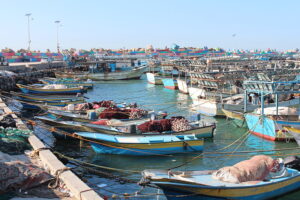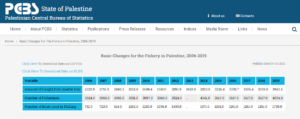Dec. 4 UPDATE:
CAMERA Prompts Editor's Note
As a result of CAMERA's research and correspondence with editors, the New York Times has published an editors' note effectively retracting the article's core premise. Significantly, the note acknowledges that "The current catch is higher than that in the early years of blockade," completely undermining the false notion that the fishing industry is "collapsing." In addition, editors updated the digital edition to include official Palestinian data showing that the fishermen's catch has risen since the blockade was put into place and amended the subheadline to delete the reference to the blockade's "devastating" impact. See below for a detailed update.
A great deal has been written about Gazans' resourcefulness in face of incredibly challenging circumstances. But no one before has ever put their finger on this particular stroke of Gazan ingenuity: The coastal territory must be the only place in the world with a collapsing fishing industry which nevertheless manages to more than double its catch.
Even the New York Times' Nov. 27 article ("Amid Israeli Blockade on Gaza, a Fishing Fleet Limps Along"), in which Raja Abdulrahim describes the Gaza fishing industry like a fish out of water gasping for air, collapsing under Israel's suffocating blockade, fails to detect this unprecedented ingenuity at play.

Gaza fishing boats, 2015 (Mahmoud Navash, CC BY-SA 4.0, via Wikimedia Commons)
"Not far from the edge of the port in the Gaza Strip lies its boat cemetery: two rows of beached fishing vessels that even Gazan ingenuity cannot salvage," she waxes on about the ailing sector which is said to be in or near its death throes.
“This is a war on our livelihoods," she quotes a local fisherman, who is "standing on the bow of one of his family’s boats, which has been in the cemetery for years." The graphically-described emotive story that she wants readers to buy hook, like and sinker is exactly as her Tweet says: "For Gaza’s fishermen, Israel's blockade has prevented import of materials needed to repair boats and maintain a functioning fishing fleet. It has damaged a vital but shrinking part of the economy in the coastal enclave."
Introducing readers to the forlorn boat cemetery, she explains: "The boats began piling up in Gaza 15 years ago after Israel, aided by Egypt, imposed a land, air and sea blockade on the small Palestinian coastal enclave in 2007." The blockade, she says, means that fishermen can't obtain critical supplies like motors, propellers, fiberglass and more needed for their trade, leading boat owners to abandon their broken, useless vessels in the ship cemetery.
"Gazan and industry officials warn that if Israeli restrictions are not eased, the strip's fishing sector could completely collapse in the next few years as more and more boats are removed from service," she recounts.
"The fishing sector now works at 50 percent capacity and every day it is decreasing," the New York Times reporter quotes Jehad Salah, head of the fisheries directorate in Gaza. "When they ban the equipment needed for maintenance then they are forcing people to leave this industry."
But, happily, as it turns out, Gazan ingenuity is alive and well. Even as the fishing sector is "decreasing" every day, it catches more and more fish!
Indeed, according to figures published by the Palestinian Central Bureau of Statistics, by all counts Gaza's fishing industry over the last 15 years has thrived during its alleged "collapse."
 In 2005, two years before the blockade was imposed in 2007, 707 fishing boats were in Gaza. By 2019, a dozen years into the blockade, that figure *more than doubled* to 1,739 boats.
In 2005, two years before the blockade was imposed in 2007, 707 fishing boats were in Gaza. By 2019, a dozen years into the blockade, that figure *more than doubled* to 1,739 boats.
Some skeptics might argue that official Palestinian statistics on Gaza fishing boats or fishermen is not a fair measure of the actual situation. Perhaps, they say , desperate, dirt-poor fishermen continue registering additional broken-down boats which they cannot use due to lack of parts.
What about other indicators about the sectors' health, despite its reported collapse? The number of fish caught, for instance, surely is an accurate reflection of the industry's actual vitality, or lack thereof. And here too the figures show remarkable growth, despite the industry's purported demise. In 2009 (see Table 3), Gaza fishermen caught 1,524,913 fish. After another decade of suffocating Israeli blockade, that figure climbed to 3,943,369 in 2019!
The story @RajaAbdulrahim wants us to swallow hook, line & sinker: Israel's 15-year blockade is increasingly devastating Gaza's fishing industry, as poignantly illustrated by boat graveyard. It's only a matter of time until the sector completely collapses, she reports (1/6) https://t.co/F6oTNeN3Av pic.twitter.com/4dSIJnu2it
— Tamar Sternthal (@TamarSternthal) November 28, 2022
Among readers hooked by Abdulrahim's account on the destruction of the Gaza fishing industry was Human Rights Watch's Kenneth Roth, who tweeted: "Israel's punitive blockade of Gaza is far far broader than needed to combat violent attacks. It is a form of collective punishment against the people of Gaza (not just Hamas) that, for example, is destroying Gaza's vital fishing industry."
CAMERA has appealed to The New York Times to cover this unique form of Gaza ingenuity in which the collapsing fishing industry has managed to more than double its catch in devastating 15 years of the Israeli blockade. Stay tuned for any updates.
Update, 10:55 am EST: Israeli Military: The New York Times Ignored All of Our Information
The Israel Defense Forces has tweeted that while it had provided The New York Times with extensive relevant information about smuggling attempts and about Israeli Navy efforts to assist Gaza fishermen in distress, the "Paper of Record" excluded all of it.
The IDF sent The New York Times this statement in response to their query about this issue.
Unfortunately, our explanation did not feature in the article. 2/3 pic.twitter.com/mzDrrpf4n3
— Israel Defense Forces (@IDF) November 28, 2022
Dec. 4 Update: New York Times Corrects
After CAMERA provided editors with official Palestinian statistics demonstrating that the fishermen's catch has more than doubled since the blockade was imposed, the print edition published the following Editor's Note on Dec. 3, and also appended a similar note to the bottom of the digital article:
INTERNATIONAL
An article last Sunday about the struggles of Gaza's fishing sector omitted important context surrounding the impact of Israel's blockade on the industry, leaving the impression that the industry had been devastated. While the blockade has led to a shortage of parts needed to keep some fishing boats operational, the annual catch has varied from year to year. The current catch is higher than that in the early years of blockade.
In addition, editors amended the digital subheadline which had initially stated: "An Israeli blockade that restricts the movement of Gazans out of the strip and limits imports — or bans them completely — has been devastating for the enclave’s fishing industry." The revised headline makes the more modest claim that "An Israeli blockade that restricts the movement of Gazans out of the strip and limits imports — or bans them completely — is hobbling the enclave’s fishing industry." In addition, the following text within the digital article was amended:
Gazan and industry officials warn that if Israeli restrictions are not eased, the strip’s fishing sector could completely collapse in the next few years as more and more boats are removed from service.
It now includes statistics from the Palestinian Central Bureau of Statistics indicated that the catch has increased since the blockade was imposed:
The total catch in Gazan waters has risen in recent years, according to the Palestinian bureau of statistics, from 2,322.9 metric tons in 2006 to 3,943.4 in 2019, when Israel expanded the permitted fishing zone to 15 nautical miles in some areas from six, but still short of the 20 nautical miles agreed to under the Oslo accords, the 1990s peace agreement that was supposed to lay the path for Palestinian statehood.
Despite that increase, Gazan and industry officials say that the core of the fishing fleet has been hobbled by the restrictions on the import of motors and other parts…
